Seasonal variation of airborne fungi of the Tiantishan Grottoes and Western Xia Museum,Wuwei,China
YuLong Duan,FaSi Wu,DongPeng He,RuiHong Xu,HuYuan Feng,Tuo Chen,GuangXiu Liu,WanFu Wang,*
1.Northwest Institute of Eco-Environment and Resources,Chinese Academy of Sciences,Lanzhou,Gansu 730000,China
2.National Research Center for Conservation of Ancient Wall Paintings and Earthen Sites,Dunhuang Academy,Dunhuang,Gansu 736200,China
3.MOE Key Laboratory of Cell Activities and Stress Adaptations,School of Life Sciences,Lanzhou University,Lanzhou,Gansu 730000,China
4.School of Environment and Municipal Engineering,Lanzhou Jiaotong University,Lanzhou,Gansu 730000,China
5.Naiman Desertification Research Station,Northwest Institute of Eco-Environment and Resources,Chinese Academy of Sciences,Tongliao,Inner Mongolia 028300,China
ABSTRACT In this study,a systematic survey of cultural airborne fungi was carried out in the occurrence environments of wall paintings that are preserved in the Tiantishan Grottoes and the Western Xia Museum,China.A bio-aerosol sampler was used for sampling in four seasons in 2016.Culture-dependent and-independent methods were taken to acquire airborne fungal concentration and purified strains;by the extraction of genomic DNA,amplification of fungal ITS rRNA gene region,sequencing,and phylogenetic analysis,thereafter the fungal community composition and distribution characteristics of different study sites were clarified.We disclosure the main environmental factors which may be responsible for dynamic changes of airborne fungi at the sampling sites.The concentration of cultural airborne fungi was in a range from 13 to 1,576 CFU/m3,no significant difference between the two sites at the Tiantishan Grottoes,with obvious characteristics of seasonal variation,in winter and spring were higher than in summer and autumn.Also,there was a significant difference in fungal concentration between the inside and outside of the Western Xia Museum,the outside of the museum was far more than the inside of the museum in the four seasons,particularly in the winter.Eight fungal genera were detected,including Cladosporium, Penicillium, Alternaria,and Filobasidium as the dominant groups.The airborne fungal community structures of the Tiantishan Grottoes show a distinct characteristic of seasonal variation and spatial distribution.Relative humidity,temperature and seasonal rainfall influence airborne fungal distribution.Some of the isolated strains have the potential to cause biodeterioration of ancient wall paintings.This study provides supporting information for the pre-warning conservation of cultural relics that are preserved at local sites and inside museums.
Keywords:airborne fungi;community characteristics;ancient wall paintings;monitoring and pre-warning
1 Introduction
Microorganisms,including bacteria and fungi,are pervasively found in almost all types of habitats in cultural heritage sites on earth,such as rock caves,cave temples,archaeological sites and museums.The growth of microorganisms may contribute to the severe biodeterioration of fragile artworks(Schabereiter-Gurtneret al.,2004;Gonzalezet al.,2008;Maet al.,2015;DeAraujoet al.,2016;Duanet al.,2017).Previous studies have documented microbial outbreaks causing aesthetic and mechanical damage of murals such as pigment discoloration,cracking and disintegration of painted layers caused by contamination and biofilm formation on the painted surface,and flaking of the painted layer from the underlying support layer because of binders' degradation(Schabereiter-Gurtneret al.,2002;Dupontet al.,2007;Portilloet al.,2009;Bastianet al.,2010;Feliceet al.,2010;Pepeet al.,2010).The atmosphere is an important microbe's reservoir with about 1,200 species of bacteria and actinomycetes and 40,000 species of fungi (Songet al.,2000).Thus,air-exchange is the main reason for the transportation and dispersion of microorganisms.In many cases,microorganisms attached to the surface of cultural relics such as murals can risk biodeterioration of the substratum materials.This is particularly true under environmental conditions of rich nutrient supply,favorable temperature,relative humidity,pH or sunlight for the growth and proliferation of microbes (Michaelsenet al.,2006).Therefore,studies that have been carried out on the airborne microflora in various historical sites may help us understand the process of biological degradation of artworks and provide data as supporting preventive heritage conservation and tourism management(Nugariet al.,1993).
Ancient murals are a valuable cultural heritage and can be divided intoin-situandex-situconservation according to their storage location.The former refers to the primary environment of murals such as caves,temples and catacombs.If the original environment of these murals were drastically altered and even threatened their conservation,they were often removed and transported to museum forex-situconservation (Wanget al.,2015).Airborne microorganisms usually exist as bioaerosols which are attached to floating dust and other soil particles,most of which have natural and anthropogenic sources,such as plants,soils,vegetables,animal feeding,agricultural activities,and transportation industry (Bonazzaet al.,2016).Colony forming units(CFU)is commonly used to calculate the numbers of cultural airborne microorganism per cubic meter of air (CFU/m3).This measurement of airborne microorganisms is an important ecological indicator for early warning and environmental control of microbial outbreaks which refers to biodeterioration of cultural relics at various heritage sites (Wanget al.,2010a;Wanget al.,2010b;Docampoet al.,2011;Wuet al.,2012;Eet al.,2013).
Recently,both culture-based methods and DNAbased molecular approaches such as clone library method based on 16S ribosomal DNA/RNA or ITS(Internal transcribed spacer) regions,PCR-DGGE,NGS (Next-Generation Sequencing) have been widely employed on biological identification of airborne microbes in various historical sites (Wanget al.,2012;Gaüzèreet al.,2014;Tanget al.,2017).Previous studies revealed that airborne microbial concentration and community composition varied greatly among heritage sites,particularly for indoor and outdoor museums (Gaüzèreet al.,2013;Gaüzèreet al.,2014;Lazaridiset al.,2015;Anayaet al.,2016).Meanwhile,the microbial concentration and community composition in the atmosphere are influenced by various factors,mainly natural environment variation (e.g.,air temperature,relative humidity,sunlight,wind and rainfall) and artificial disturbance(e.g.,tourists' activities) (Tanakaet al.,2015;Xueet al.,2017).For example,when tourists enter a cave,catacomb or museum,this may break the primitive conservation environment of cultural relics and cause issues such as increasing CO2concentration,temperature and relative humidity (Zhanget al.,2005;Saiz-jimenezet al.,2011).Furthermore,tourists may transfer particulate materials and carry exogenous microbes into cave ecosystems,leading to an increase of particle material concentration and change of airborne microbial communities (Bastianet al.,2009;Yanet al.,2012).In the realm of public health,numerous airborne microbes act as opportunistic pathogens that lead to human diseases (Carloet al.,2016;Xueet al.,2017).
At present,there are few studies on the discrepancy of airborne microbial community characteristics caused by the change of cultural heritage preservation environment.As an important cultural heritage site,there were no reports of the concentration and community composition of cultural fungi in the atmosphere at the Tiantishan Grottoes.Previously,we found that murals conservation state in the Tiantishan Grottoes have changed drastically,causing fungal invasion of the murals after transfer to the Western Xia Museum (Duanet al.,2018).In this study,we aimed to compare the concentration and community structure difference of airborne fungi at two sites where murals are preserved,namely the Tiantishan Grottoes and the Western Xia Museum.Combined with environmental monitoring data,we disclose the main factors which are responsible for dynamic changes of the airborne fungi at these two sites.
2 Materials and methods
2.1 Sites description
Tiantishan Grottoes,historically known as "Liangzhou Grottoes",are located north of Tiantishan,approximately 60 km south of Wuwei City,which is a typical northwestern city located in the eastern Hexi Corridor in Gansu Province,China (Figure 1a).These caves of the Tiantishan Grottoes were built in the Northern Liang (401-439A.D.) of the Sixteen Kingdoms period about 1,600 years ago.Grottoes not only played an important role in spreading Buddhism and propagating Buddhist art in the Hexi Corridor region on the Silk Road,but also had a profound influence on art characteristics of the grottoes in later generations,including the World Heritage Sites of Yungang Grottoes and Longmen Grottoes.Both of these sites are representative grottoes in China.Therefore,Tiantishan Grottoes is called the "Origin of Grottoes"in the academic field.

Figure 1 Four sampling sites for airborne fungi at the Tiantishan Grottoes and the Western Xia Museum.(a)Location of the Tiantishan Grottoes in Gansu Province;(b-c)Caves 13 and 18 of the Tiantishan Grottoes,respectively;(d-e)Inside and outside of the Western Xia Museum,respectively
Tiantishan Grottoes are inland and situated in the basin valley between the Qilian Mountains and the south mountains of Hexi corridor.The basin has a cold climate of semi-arid and high land with an average annual temperature of 4.9 ℃and annual rainfall of 159 mm.Because of historical factors (Duanet al.,2018),most priceless historical objects including murals and painted sculptures of the Tiantishan Grottoes were relocated to the Gansu Provincial Museum forex-situprotection in 1959.Only a few mutilated remains of murals or painted sculptures were left in the original location at the Tiantishan Grottoes.Beginning in 2006,these historical objects were gradually returned to their birthplace,namely Tiantishan Grottoes.However,due to seismic damage,festinate relocation,immature exfoliating technology,and poor conservation environment,these priceless cultural objects suffered from various problems,including paint loss,detachment,flaking,and microbial deterioration.In this case,salvageable restoration must be finished before it is relocated.Presently,salvageable restoration of these objects was carried out in the Western Xia Museum of Wuwei city.
2.2 Sampling process
Four sites were selected for the sampling of aerosols in four seasons (represented by April,June,October,and December) in 2016.They include Cave 13 and Cave 18 of the Tiantishan Grottoes,a warehouse inside and a square outside of the Western Xia Museum,named TT13,TT18,TMI,and TMO,respectively(Figures 1b-1d).In Cave 13,there is a giant 23.8 m sitting Shakyamuni Statue which was protected from water by a semi-enveloping cofferdam constructed by reinforced concrete.In Cave 18,only a central tower with a Buddha Statue remained.Its position is higher than Cave 13 with an open and flat landform.Caves 13 and 18 are two sites of the Tiantishan Grottoes which have surviving wall paintings.The Western Xia Museum is located southeast of the Confucius' temple in Wuwei City.The outside square of the museum and surrounding areas have constant activity of people and vehicles.However,the warehouse inside of the museum has been employed to store uncovered wall paintings of the Tiantishan Grottoes,where these artworks have been gradually restored in recent years.It should be noted that restoration work of cultural relics was only carried out during the period from April to November and suspended during the remainder of the year,without human disturbance,due to local bitter-cold weather.
A Buck Bio-Culture Model B30120 sampler (A.P.Buck Inc.USA) was used to sample the atmosphere in the Tiantishan Grottoes and the Western Xia Museum.At each site,the sampler was installed 1.5 m above ground level with a supporting platform.Airflow rate of the sampler was set at 90 L/min and samples were carried out for 2 min,with three parallel repetitions.For each sampling,the bio-aerosol sampler is loaded with 90 mm Petri dishes containing Potato Dextrose Agar (PDA) medium.Exposed culture dishes were incubated for 7-15 days at room temperature of 25 ℃.
2.3 Fungal identification
Colony forming units (CFU) on the plates were enumerated,and fungal concentrations were expressed as per cubic meter of air(CFU/m3).Cis calculated below:

whereCis airborne fungi concentration (CFU/m3);Tis total colony on the PDA plates;tis sampling time(min);Fis airflow rate(L/min).
After incubation,microbial colonies were counted and fungi were preliminary identified according to morphological characteristics such as shape,size,color,and refractivity.The isolates were identified by using a molecular method as described below.Each isolate was homogenized in liquid nitrogen and then genomic DNA was extracted by using a commercially available extraction Kit (Tiangen Co.,Beijing,China)according to the manufacturer's protocols.The internal transcribed spacer (ITS) region of fungal rRNA genes was amplified with the following universal primer set:ITS1 (5'-TCCGTAGGTGAACCTGCGG-3') and ITS4 (5'-TCCTCCGCTTATTGATATGC-3') (Whiteet al.1990).The reaction mixture (25 μL) consisted of 2.5 μL 10 × PCR buffer,1-unitTaqpolymerase(Tiangen Co.,Beijing,China),0.2 mmol/L dNTPs,2.5 mmol/L MgCl2,0.2 μmol/L each primer,and 2.5 μL(about 10 ng DNA) template.The PCR program included an initial denaturation at 94 ℃for 5 min,30 cycles at 94 ℃for 40 s,annealing at 55 ℃for 40 s,an extension at 72 ℃for 40 s,and a final extension step at 72 ℃for 10 min.The PCR products were detected by electrophoresis on 1.0%agarose gel.
Similarities among PCR products were determined by restriction fragment length polymorphisms(RFLP) analysis.The PCR products were digested with the double restriction endonucleasesBsuRI andHinfI (MBI,Fermentas).Then,the digested fragments were differentiated into several clusters according to their spectral patterns on 2.5%agarose gel.
Cloning of PCR products of distinctive strain were performed with the pGEM-T Vector System(Tiangen Co.,Beijing,China) following their manufacturer's instructions,and the ligation products was subsequently transformed intoEscherichia coliDH5α competent cells (Tiangen Co.,Beijing,China),which allows Blue-White selection.The transformants were plated on LB medium with ampicillin (100 mg/mL),X-Gal (20 mg/mL) and IPTG (200 mg/mL).Positive clones were identified by PCR amplification with the pGEM-T vector primer pairs (T7/SP6) by using the same program as ITS amplification.
Fungal suspensions of expected clones were sequenced by the Shanghai Majorbio Bio-technology Co.,Ltd.(Shanghai,China).A total of 34 fungi representative sequences were obtained (about 600 b.p.)and then analyzed via the National Center for Biotechnology Information (NCBI) Blast program (https://blast.ncbi.nlm.nih.gov/Blast.cgi).The most similar sequences were extracted from the GenBank database.A phylogenetic neighbor-joining tree was constructed via the MEGA software 7.0.The sequences retrieved during this study can be accessed under the data range of MH042805-MH042838.
2.4 Data of environmental parameters
Meteorological data was collected in all four sampling sites for one year (from April 16,2016 to April 16,2017).Temperature (T,°C) and relative humidity(RH,%) were collected by HOBO®U23-001 Temp/RH data logger (Onset Computer Corporation,USA).Data of rainfall was provided by local weather bureaus.For all environmental parameters,the values used in data analyses were 10-day averages from before and after the sampling days.
2.5 Statistical analysis
All the experiments were analyzed by one-way analysis of variance(ANOVA)via SPSS version 16.0.The relationships between airborne fungi concentration and environmental parameters were tested via Pearson correlation analysis.Shannon-Weiner diversity index of fungal communities were generated using the Vegan packages in R (4.0.0).Canonical correlation analysis (CCA) for airborne fungal communities and environmental parameters were then analyzed using CANOCO version 4.5.
3 Results
3.1 Fungal concentrations
Considering all four sampling sites,the concentration range of cultural fungi was from 13 to 1,576 CFU/m3,and the mean and median values were 603 ± 57 CFU/m3and 525 CFU/m3,respectively(Table 1).The highest fungal concentration appeared in TMO,and significantly higher than those in TT18,TT13,and TMI(P<0.05).

Table 1 Total airborne fungi(CFU/m3)enumerated on PDA agar plates from the four sites
The cultural airborne fungal concentrations of the four sites show obvious seasonal variation characteristics (Figure 2).The highest concentration was observed in winter at TT18 with 887 CFU/m3and TT13 with 689 CFU/m3,and in autumn at TMO with 1,576 CFU/m3and TMI with 674 CFU/m3.The lowest concentration was observed in autumn at TT18 with 226 CFU/m3and TT13 with 374 CFU/m3,spring at TMO with 852 CFU/m3,and in winter at TMI with 13 CFU/m3.

Figure 2 Fungi concentrations(CFU/m3)at the four sites in different seasons(April,June,October,December).Different lower-case letters indicate significant differences(P<0.05)among different sampling sites in different season
In the same season,there was no significant difference in airborne fungal concentration between TT18 and TT13 in the two sampling sites of the Tiantishan Grottoes (P>0.05).Meanwhile,airborne fungal concentration in the square outside of the Western Xia Museum (TMO) was significantly higher than in the warehouse inside of the museum (TMI),especially in winter(P<0.05).
To evaluate the relationship between environmental parameters (T,RH and rainfall) and fungi concentrations,Pearson correlation analysis was performed(Table 2).It is observed that T,RH and rainfall had negative effects on the fungal concentration at the two sampling sites of cave 18(TT18)and cave 13(TT13),while these environmental parameters had positive effects on the fungal concentration outside of the Western Xia Museum (TMO).Meanwhile,we also observed that T and RH had positive effects on the fungal concentration inside the museum(TMI).
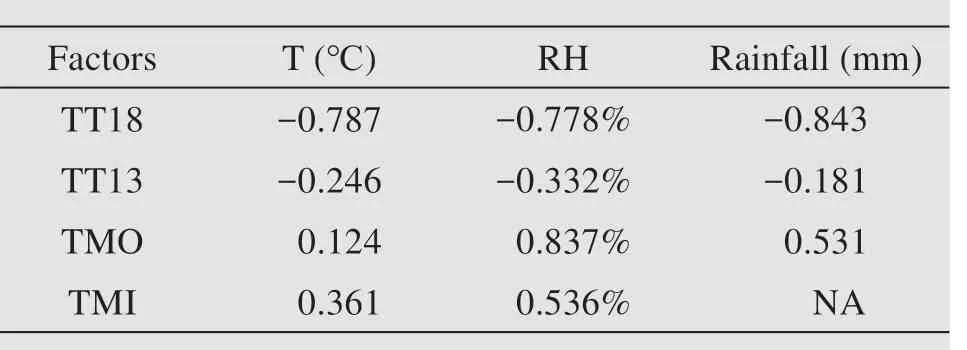
Table 2 Pearson correlation analysis for fungal concentrations(CFU/m3)and environmental parameters
3.2 Phylogenetic analysis of the airborne fungal communities
In this study,a total of 34 sequences were classified into eight different fungal genera corresponding to the GenBank database.The phylogenetic tree is presented in Figure 3.Among them,seven genera were affiliated to Ascomycota and one was Basidiomycota.Cladosporium(45.38%) was the most predominant fungal genus,followed byPenicillium(38.62%),Alternaria(8.09%) andFilobasidium(6.25%).These four fungal genera accounted for 98.20% of the entire community (Figure 4).The rest of the members including the generaEpicoccum,Aspergillus,Didymella,andMicrodochiumaccounted for 1.80% of the entire community.

Figure 3 Phylogenetic tree of airborne fungi based on ITS sequences
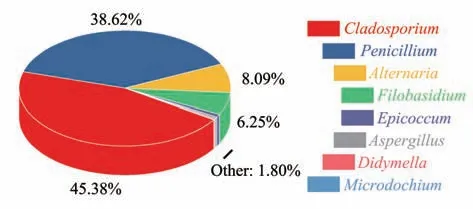
Figure 4 Proportions of fungal genera detected in atmosphere environment of the Tiantishan Grottoes and the Western Xia Museum
The Shannon-Weiner index represents the diversity of fungal communities.The changes in the Shannon-Weiner index of fungal communities at the four sampling sites are presented in Figure 5.The mean value of the Shannon-Weiner index differed among the four sampling sites (1.12 in TT18,0.93 in TT13,0.71 in TMO,0.74 in TMI) and fluctuated markedly among different seasons.The highest diversity index values were as follows:spring at TT18(1.73),autumn at TT13 (1.43),summer at TMO (1.07),and winter at TMI (0.96).The lowest diversity index was spring in TMO(0.33).
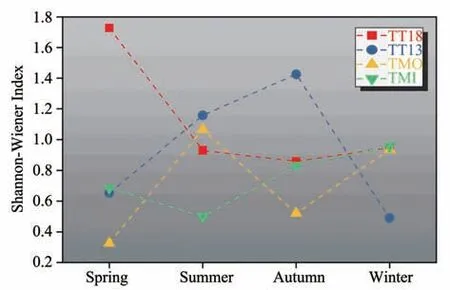
Figure 5 Seasonal changes in Shannon-Weiner index of airborne fungal communities at the four sampling sites
The structure of cultural fungal communities varied greatly at different sampling sites in four seasons.The most prevalent fungal genera are presented in Figure 6.CladosporiumandPenicilliumwere the most frequently discovered airborne fungi at four sampling sites.In spring,Penicillium(35.90%) was the major genus in TT18,followed byCladosporium(29.06%),Epicoccum(11.97%),Filobasidium(11.97%) andAlternaria(9.40%).Penicillium(56.41%) andCladosporium(43.59%) were the main genus in TMI.Meanwhile,Cladosporiumaccounted for 83.33% of the whole community in TT13,and the rest of the members includeDidymella,Epicoccum,andFilobasidiumcollectively accounted for only 16.67%.Cladosporiumwas the largest genus accounting for 95.38%in TMO.In summer,the proportion ofPenicilliumandFilobasidiumsignificantly increased to 55.25%and 37.74% in TT18,respectively.Meanwhile,in TT13,the proportion ofCladosporiumsharply decreased to 47.20%,and the genera ofAlternariaandPenicilliumaccounting for 19.88% and 29.19%,respectively.In addition,Cladosporiumwas still the largest genus both in TMO and TMI,and its proportion was very close to each other with 76.99% and 80.00%,respectively.In autumn,AlternariaandCladosporiumdominated in TT18 and TT13,both of which accounted for 72.00%,24.00% and 60.98%,21.95%,respectively.The proportion ofCladosporiumsharply decreased to 21.55% and 13.41% in TMO and TMI,respectively.Meanwhile,the proportion ofPenicilliumincreased to 78.45% and 81.01% in TMO and TMI as the dominant genera,respectively.In winter,the proportion ofAlternariasharply decreased to 0.00%and 19.23%in TT18 and TT13,but the proportion ofCladosporiumsharply increased to 64.58%and 80.77% in TT18 and TT13,respectively.CladosporiumandPenicilliumwere making up to 56.46%and 43.54% in TMO,respectively.In addition,Alternaria,Cladosporium,andDidymellareached to 57.14%,28.57%,and 14.29%in TMI,respectively.
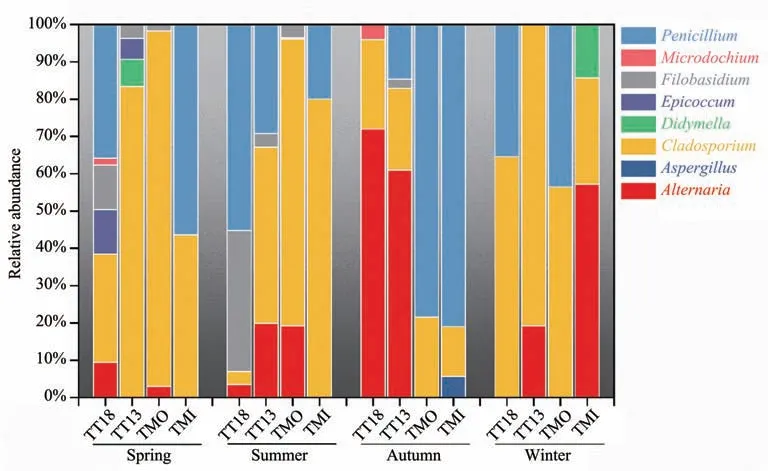
Figure 6 Relative abundance of the dominant fungal genera at the four sites
3.3 The contributions of environmental parameters to community structure of airborne fungi
The relationships between fungal community structure and environmental parameters were determined by canonical correlation analysis (CCA).The results show that the community structure of cultural fungi varied greatly among the different sampling sites in different seasons (Figure 7).The contribution of environmental parameters to the fungal community distribution was ranked as rainfall (0.097),T(0.049),andRH(0.042) by descending order.Among seasons,the fungal community structure was relatively similar at the four sites between summer and autumn,as well as in spring and winter,respectively.Moreover,the community structure of the four seasons was more similar to TMI.
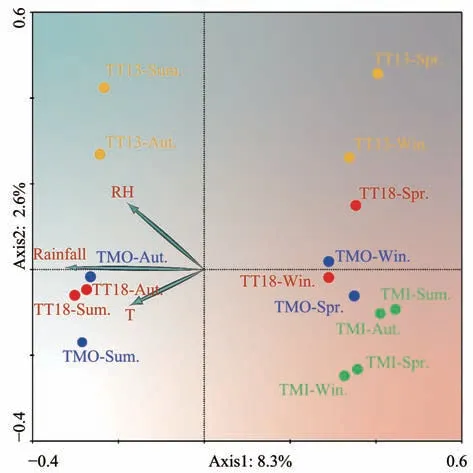
Figure 7 Canonical correlation analysis for fungal communities and environmental parameters from the four sites in different seasons
4 Discussions and conclusions
In this study,we explored the temporal-spatial dynamics of airborne fungal community in two different occurrence conditions for wall paintings of the Tiantishan Grottoes,China.The results show that cultural fungal concentration in the atmosphere was very close between TT13 (504 CFU/m3) and TT18(559 CFU/m3) due to close proximity,within noticeable seasonal fluctuation,and higher fungal concentrations were recorded in winter and spring than those in summer and autumn.Meanwhile,airborne fungal concentration at TMO was far higher than TMI through all four seasons (P<0.05),autumn in particular.The fungal concentration at the two sites reached the highest level with 1,576 CFU/m3in TMO and 674 CFU/m3in TMI,which may be attributed to optimal nature conditions (i.e.,high temperature and relative humidity) for fungal spores' germination in autumn (Burch and Levetin,2002;Stennett and Beggs,2004).
In general,local climatic conditions,including but not limited to temperature and relative humidity,may provide optimal environmental conditions for fungal growth.For temperature,previous studies revealed that airborne fungal concentrations at outdoor sites increased with rising temperature (Sabariegoet al.,2000;Burch and Levetin,2002;Stennett and Beggs 2004;Gu,2007).For air humidity or rainfall,some studies noted that fungal spore concentrations,including ascospores and basidiospores increased with humidity or rainfall (Troutt and Levetin,2001;Stennett and Beggs,2004).However,some studies argue that higher humidity may also means a rainfall condition,which could remove ambient fungal spores,especially for dry-air spores (Burge and Rogers,2000;Weber,2003).Thus,the effects of relative humidity on airborne fungi were inconsistent in different studies,particularly considering climatic factors,e.g.,temperature and rainfall.Interestingly,pearson correlation analysis revealed that there was a positive correlation between airborne fungal concentration and three domestic climatic parameters,including temperature,relative humidity and rainfall both in TMO and TMI,but with a negative correlation at TT18 and TT13.In Wuwei city,low temperature and low rainfall due to highcold and semi-arid climatic conditions might be the primary reason for the positive correlation on total fungal level with temperature,relative humidity and rainfall at the outside and inside of the museum,respectively.The co-efficient of the temperature rising and seasonal rainfall could result in an increase of relative humidity,which is beneficial to the germination and proliferation of airborne fungal spores.Meanwhile,low temperature and high relative humidity due to the special microhabitat of the Tiantishan Grottoes may be responsible for negative correlation on fungal concentrations with three climatic parameters at TT18 and TT13,respectively.These two sites are located upstream of an artificial lake,named Huangyang River Reservoir.Core microbial groups in the atmosphere may be insensitive to high relative humidity and are more adapted to lower temperatures.Of course,the reasons for this phenomenon still needs further study.In addition,human activities also have a pronounced effect on airborne fungal concentration,especially between the outside and inside of the Western Xia Museum,which is located in the urban areas of Wuwei city with a proliferation of people,vehicles,floating dust and microbial concentration in the atmosphere (Bastianet al.,2009;Saiz-jimenezet al.,2011).In contrast,inside the museum with low airborne fungal concentration depends on its own barrier effect on external air pollutants and strict environmental control by the staff.This is especially true during winter when the restoration of damaged murals was suspended and the lack of human intervention of the internal environment(Duanet al.,2019),such that the fungal concentration fell to 13 CFU/m3.
The airborne fungal communities of all sites that were investigated in this study show differences in their structures,but without any detected fungal genus that is unique and associated especially to one site.Eight fungal genera were picked from the PDA plates with the aid of ITS-based biological identification method.Cladosporiumwas the most frequently found fungi,followed byPenicillium,andAlternaria.They were the most frequently isolated genera in the air of the Tiantishan Grottoes and the Western Xia Museum,and these results are consistent with previous studies carried out on urban areas and caves (Fanget al.,2005;Fernandez-Corteset al.,2011;Vanderwolfet al.,2013;Puszet al.,2015).The abundance of airborne fungi in the Tiantishan Grottoes and Western Xia Museum were influenced by both research sites and sampling periods.Among the four sites,TT18 show the highest Shannon index value and TMO show the lowest.Meanwhile,not only the mean value of the Shannon-Weiner index at TT18 was close to TT13,but also for TMO and TMI (Figure 5).In addition,the highest diversity index values were observed in four seasons,namely spring (TT18),autumn(TT13),summer (TMO),and winter (TMI).This suggests that airborne fungal diversity at our study site depended on both the local environment and sampling seasons.
Fungi plays a considerable role in the deterioration of cultural heritage (Sterflinger,2010).Research in Lascaux Cave declared that the metabolic activity of fungi is a larger order of magnitude than bacteria;therefore,they have considerably higher biodeteriorative potential than bacteria (Bastianet al.,2010);Their ability to form hyphae,fungi may colonize and damage precious historical objects such as books,mural paintings and architectural surfaces (Huet al.,2013;Maet al.,2015;Pinaret al.,2015;Paiva de Carvalhoet al.,2018).It is demonstratedin vitrobiodegradation potential test of airborneAspergilliandPenicilliumthat they have an excellent capacity for carbonate dissolution,acid excretion,alkaline metabolites,cellulolytic activity,and extracellular pigment production (Savkovićet al.,2019).Also,many members of airborne fungi,such asCladosporium,Penicillium,Alternaria,andAspergillusare considered as ubiquitous opportunistic pathogens to humans and may induce respiratory diseases such as rhinitis,sinusitis,asthma and alveolitis,which may pose potential threats to visitors (Fanget al.,2005;Carloet al.,2016).Therefore,when humans appear in some relatively enclosed space like caves and museums,periodic ventilate measures should be taken in these places to alleviate the potential dangers for cultural relics and staff.
The airborne fungal dynamics of the Tiantishan Grottoes and Western Xia Museum show a notable seasonal periodicity and fluctuations,which are mainly caused by local environmental factors including temperature,relative humidity,solar radiation,wind speed and rainfall,as well as human disturbance and adaptability of airborne microorganisms to local environments (Jones and Harrison,2004;Wanget al.,2012;Tanakaet al.,2015).Canonical correlation analysis results show that factors of rainfall,temperature,and relative humidity all have some effects on airborne fungal communities among sampling sites.Briefly speaking,they have a positive effect on three sampling sites of TT18,TT13,and TMO in summer and autumn,which are mainly attributed to favorable external conditions for microorganisms' growth and proliferation due to warm and wet weather conditions during these periods.However,environmental parameters including wind speed,wind direction,solar radiation,and human disturbances were not taken into consideration during the analysis due to data absence of these factors.These factors may play a vital role on the composition and distribution of airborne fungi that still need further study.
In conclusion,prominent seasonal variation of airborne fungal concentrations,community structures and distribution patterns found in this study have a close relationship with local climate conditions of the Tiantishan Grottoes.It is necessary to carry out long term monitoring of airborne fungal flora in the future,and integrate it into a pre-warning monitoring and conservation system.This study provides supporting information for the scientific protection of cultural relics that are preserved at local sites and museums.
Acknowledgments:
This study was supported by the National Natural Science Foundation of China (Nos.32060258,32060277);Science and Technology Plan of Gansu Province (Nos.20YF8WF016;18JR3RA004),the"Light of West China"Program of the Chinese Academy of Sciences and Project of Gansu Cultural Relics Bureau(GWJ202011).
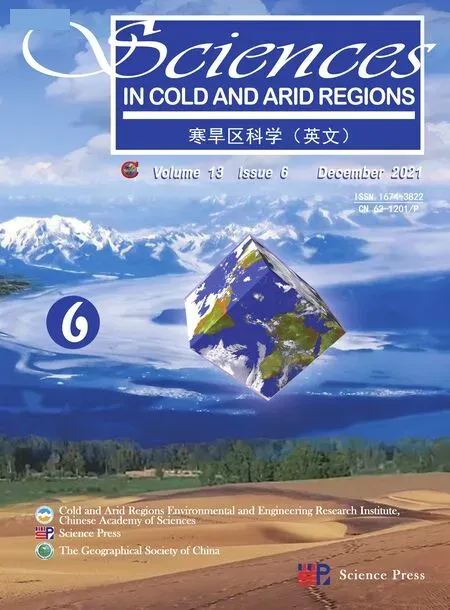 Sciences in Cold and Arid Regions2021年6期
Sciences in Cold and Arid Regions2021年6期
- Sciences in Cold and Arid Regions的其它文章
- Cryogenic wedges on the NE Qinghai-Tibet and Ordos Plateaus:Their characteristics,origin and OSL dating
- High-precision measurements of the inter-annual evolution for Urumqi Glacier No.1 in eastern Tien Shan,China
- Editor-in-Chief Yuanming Lai
- Satellite-measured water vapor isotopologues across the Tianshan Mountains,central Asia
- Climate response and radial growth of Pinus tabulaeformis at different altitudes in Qilian Mountains
- Long-term effects of gravel-sand mulch thickness on soil microbes and enzyme activities in semi-arid Loess Plateau,Northwest China
